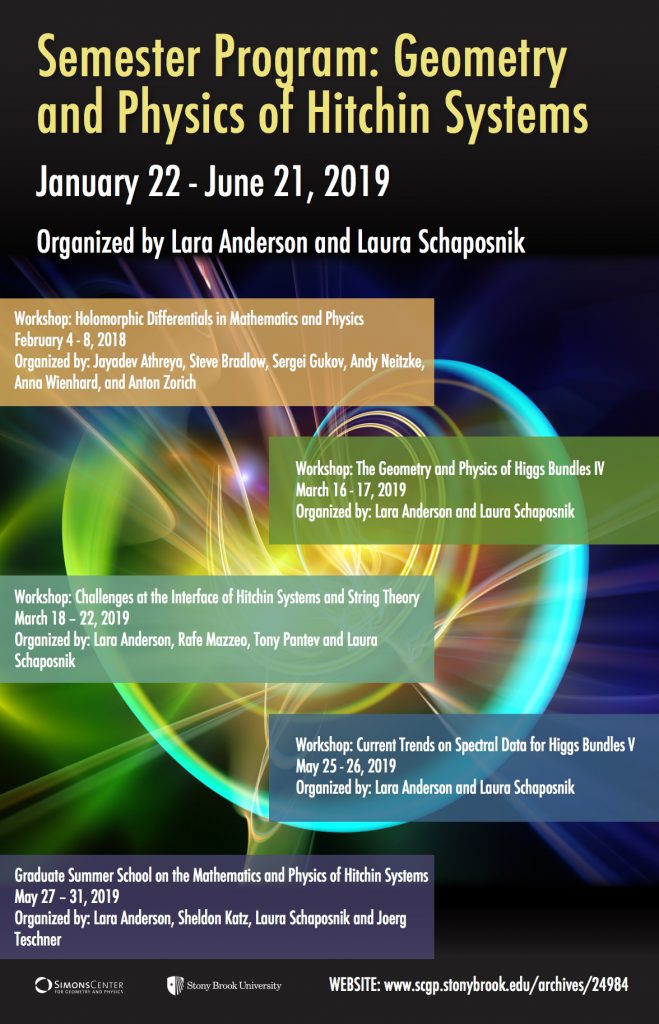Organized by Lara Anderson and Laura Schaposnik
Hitchin systems have found remarkable applications in many different areas of mathematics and physics. In particular, Hausel and Thaddeus related Higgs bundles to mirror symmetry, and in the work of Kapustin and Witten, Higgs bundles were used to give a physical derivation of the geometric Langlands correspondence. Moreover, in the last year many advances were made in the study of branes inside the moduli space of Higgs bundles, opening paths to promising new research directions.
The overall goal of the program is to bring together mathematicians and physicists working on areas close to Higgs bundles: the four interrelated themes of the program are: (A) Higgs bundles and geometric structures; (B) Higgs bundles and representation theory; (C) Higgs bundles and mirror symmetry; (D) Higgs bundles and singular geometry. Both (A) and (B) are closely interrelated, and concern in particular the study of the geometry of the moduli space, and the understanding of limits and geometric structures on this space. In particular, since many geometric structures are parametrised by the Hitchin fibration, and limits are taken in this context too, we hope that the workshop will lead to the understanding of these questions in the context of (B) and (C). Indeed, physicists have long been interested in the appearance of the Coulomb Branch (an Abelianized limit of an associated physical gauge theory), the Hitchin base, and Seiberg-Witten curves, the spectral covers of Higgs bundles. Finally, there should be algebraic connections between the above limits and Donaldson-Thomas type of invariants and wall-crossings, either in the Hitchin base or in the total space, and hence algebraic geometers can develop useful tools from this perspective. Among possible directions related to (C) is the study of the moduli space of Higgs bundles and its branes through the Hitchin fibration, appearing in mathematical physics and Langlands duality. It is from this perspective that mathematical physicists and theoretical physicists will play a key role in bringing attention to the most urgent problems in the area, and also for developing new methods centred around spectral data of Higgs bundles. Moreover, since one can use equivariant characters of certain coherent sheaves on the Hitchin moduli space to further understand the physics proposal of dualities between branes, interactions with the algebraic geometers will be of significant importance during the Workshop: Holomorphic Differentials in Mathematics and Physics February 4-8, 2018. Finally, (D), which links Calabi-Yau and Hitchin Integrable systems, is another rapidly developing area that we hope to highlight. Recent work has brought to light a remarkable isomorphism between (non-compact) Calabi-Yau integrable systems and those of Hitchin. Extensions of this correspondence to compact Calabi-Yau geometry have recently been found in the context of string compactifications but many open questions remain. In addition, links between Hitchin and Calabi-Yau moduli spaces have the potential to shed light on a number of important physical questions regarding string vacuum spaces. We expect the program to have a strong broader impact, emphasizing the presence of women and other minorities working in the area, and promoting the area amongst younger researchers. Please note that there will also be two additional workshops held during this program:
Workshop: Challenges at the Interface of Hitchin Systems and String Theory: March 18 – 22, 2019
Graduate Summer School on the Mathematics and Physics of Hitchin Systems: May 27 – 31, 2019
This program has two weekly meetings:
** A Journal Club every Friday from 12-1 (brown bag lunch) in room 313. Co-ordinated by Paul Oehlmann.
** A weekly thematic seminar every Thursday from 1-2 in 313. Full schedule can be found below (for exceptional dates please see the calendar).
| Date | Speaker | Title |
| Jan 24 | Introductory Talk | |
| Jan 31 | Paul Oehlmann | 6D Discrete Charged Superconformal Matter from F-theory on Quotient Threefolds |
| Feb 8 | Florent Schaffhauser | Higher Teichmüller spaces for orbifolds |
| Feb 14 | Andy Sanders | Opers, flat connections, and variations of Hodge structure |
| Feb 21 | Fabio Apruzzi | Non-flat elliptically fibered Calabi-Yau threefolds in F/M-theory and phases of five-dimensional superconformal field theories |
| Feb 28 | Andre Lukas | Line Bundle Cohomology and Machine Learning |
| March 8 | Katrin Wendland | On Invariants shared by Geometry and Conformal Field Theory |
| March 14 | Florian Beck | Hyperholomorphic Line Bundles and Energy Functionals |
| March 28 | Motohico Mulase | Gaiotto’s conformal limit of Higgs bundles and its geometry |
| March 29 | Marina Logares | A TQFT on representation varieties |
| April 4 | Ian McIntosh | Minimal surfaces in hyperbolic spaces and their Higgs bundles |
| April 5 | Vishnu Jejjala | Experiments with Machine Learning in Geometry & Physics |
| April 11 | Marcos Jardim | Branes on moduli spaces of sheaves |
| April 18 | Philip Boalch | Higgs bundles on the affine line and wild surface groups |
| April 19 | Paul Ziegler | p-adic integration for the Hitchin system |
| April 25 | Andres Collinucci | T-branes: Going beyond the geometric McKay correspondence |
| May 1 | Nigel Hitchin | Subintegrable systems and their special Kahler metrics |
| May 9 at 2:30pm | Marco Gualtieri | Generalized Kahler geometry and noncommutative algebraic geometry |
| May 23 | Fernando Marchesano | T-branes and Hitchin systems |
| May 24 | Misha Verbitskiy | Holomorphic Lagrangian subvarieties, Lagrangian fibrations and special Kahler geometry |
| May 31 | Pietro Longhi | Towards Enumerative Geometry with Exponential Networks |
| June 6 | John Loftin | Limits of cubic differentials and real projective structures under vanishing cycles on a surface |
| June 7 | Ljudmila Kamenova | Finiteness results for hyperkaehler manifolds |


